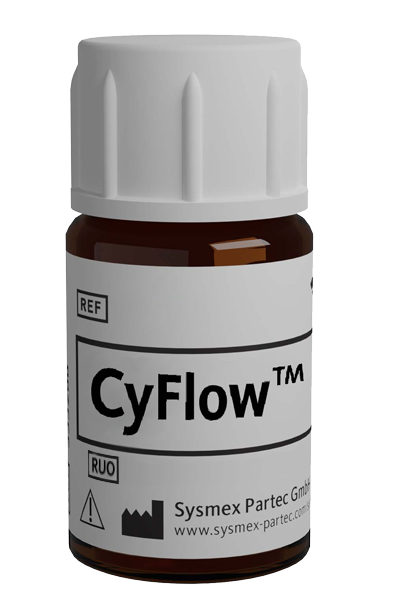CyFlow™ CD9 Biotin

| Alternative Name: | MRP-1 , P24 |
| Antibody: | Yes |
| Antigen: | CD9 |
| Application: | Flow cytometry, Western blot |
| Clonality: | monoclonal |
| Clone: | MEM-61 |
| Field of Interest: | Immunophenotyping |
| Format/Fluorochrome: | Biotin |
| Isotype: | IgG1 |
| Regulatory Status: | RUO |
| Source Species: | Mouse |
| Target Species: | Human |
| Product number: | BE166549 |
For Research Use Only
| HLDA Workshop | HLDA VI—WS Code P P-15 |
| Concentration Unit | mg/mL |
| Concentration | 1 |
| Quantity | 0.1 mg |
| Volume | 0.1 mL |
| Immunogen | NALM-6 human pre-B cell line |
| Background Information | CD9 belongs to proteins of tetraspanin family that orchestrate cholesterol-associated tetraspanin-enriched signaling microdomains within the plasma membrane, forming complexes with each other as well as with integrins, membrane-anchored growth factors and other proteins. CD9 is involved in cell motility, osteoclastogenesis, neurite outgrowth, myotube formation, and sperm-egg fusion, plays roles in cell attachment and proliferation and is necessary for association of heterologous MHC II molecules on the dendritic cell plasma membrane which is important for effective T cell stimulation. CD9 is also considered as metastasis suppressor in solid tumors. |
| Usage | The reagent is designed for indirect immunofluorescence analysis by Flow Cytometry and for Western blotting. Suggested working usage is 2.5·µg/ml (for Flow Cytometry). Indicated dilution is recommended starting point for use of this product, but working concentrations should be validated by the investigator. |
| Storage Buffer | The reagent is provided in phosphate buffered saline (PBS) solution, pH ≈7.4, containing 0.09% (w/v) sodium azide. |
| Storage | Avoid prolonged exposure to light. Store in the dark at 2-8°C. Do not freeze. |
| Stability | Do not use after expiration date stamped on vial label. |
| Kishimoto T, Goyert S, Kikutani H, Mason D, Miyasaka M, Moretta L, Ohno T, Okumura K, Shaw S, Springer TA, Sugamura K, Sugawara H, von dem Borne AEGK, Zola H (Eds): Leucocyte Typing VI. Garland Publishing Inc, New York. 1997; 1‑1342. < NLM ID: 9712219 > | Stöckl J, Majdic O, Fischer G, Maurer D, Knapp W: Monomorphic molecules function as additional recognition structures on haptenated target cells for HLA‑A1‑restricted, hapten‑specific CTL. J Immunol. 2001 Sep 1; 167(5):2724‑33. < PMID: 11509616 > | Saito Y, Tachibana I, Takeda Y, Yamane H, He P, Suzuki M, Minami S, Kijima T, Yoshida M, Kumagai T, Osaki T, Kawase I: Absence of CD9 enhances adhesion‑dependent morphologic differentiation, survival, and matrix metalloproteinase‑2 production in small cell lung cancer cells. Cancer Res. 2006 Oct 1; 66(19):9557‑65. < PMID: 17018612 > | Unternaehrer JJ, Chow A, Pypaert M, Inaba K, Mellman I: The tetraspanin CD9 mediates lateral association of MHC class II molecules on the dendritic cell surface. Proc Natl Acad Sci USA. 2007 Jan 2; 104(1):234‑9. < PMID: 17190803 > | Israels SJ, McMillan-Ward EM: Platelet tetraspanin complexes and their association with lipid rafts. Thromb Haemost. 2007 Nov; 98(5):1081‑7. < PMID: 18000614 > | Kim YJ, Yu JM, Joo HJ, Kim HK, Cho HH, Bae YC, Jung JS: Role of CD9 in proliferation and proangiogenic action of human adipose‑derived mesenchymal stem cells. Pflugers Arch. 2007 Nov; 455(2):283‑96. < PMID: 17668233 > | Singh AB, Sugimoto K, Dhawan P, Harris RC: Juxtacrine activation of EGFR regulates claudin expression and increases transepithelial resistance. Am J Physiol Cell Physiol. 2007 Nov; 293(5):C1660‑8. < PMID: 17855771 > | Lafleur MA, Xu D, Hemler ME: Tetraspanin proteins regulate membrane type‑1 matrix metalloproteinase‑dependent pericellular proteolysis. Mol Biol Cell. 2009 Apr; 20(7):2030‑40. < PMID: 19211836 >
